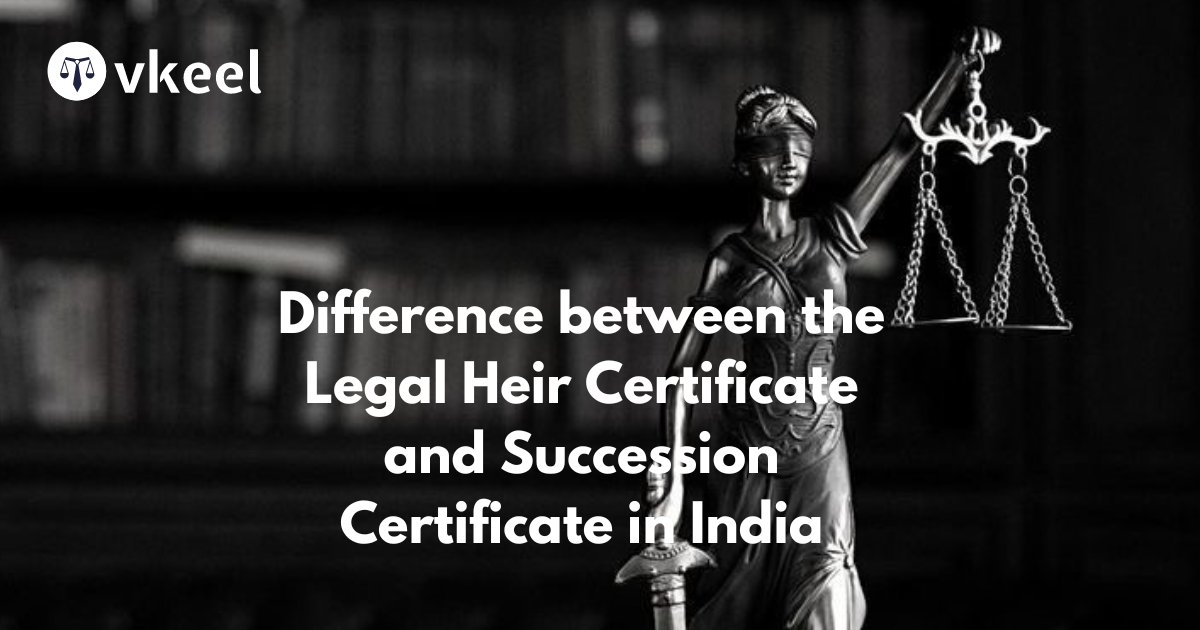Difference between the Legal Heir Certificate and Succession Certificate in India
By Himanshu Kumar
Table of Contents
Introduction
In Indian inheritance laws, two pivotal documents often come into play: the Legal Heir Certificate and the Succession Certificate. While both serve to identify the rightful heirs of a deceased person, their purposes, scopes, and procedures differ significantly.
The primary objective of a Legal Heir Certificate is to identify and establish the rightful heirs of a deceased individual for administrative purposes. This certificate is typically used to facilitate the transfer of various assets and claims, such as family pensions, insurance policies, utility services, and bank accounts. Issued by local government authorities like the Taluk Office or Tehsildar, the Legal Heir Certificate simplifies the process for heirs to settle administrative matters and access the deceased’s entitlements, ensuring that these are appropriately transferred to the legitimate beneficiaries without extensive legal proceedings.
In contrast, the primary objective of a Succession Certificate is to legally empower the heirs to inherit and manage the movable assets and debts of the deceased, particularly in the absence of a will. Issued by a civil court, this certificate is crucial for handling significant financial transactions, such as withdrawing money from bank accounts, transferring securities, and claiming debts owed to the deceased. The Succession Certificate provides a legal assurance to financial institutions and debtors, protecting them from potential disputes or legal challenges, and ensuring that the transfer of assets is conducted with judicial oversight and legitimacy.
Legal Heir Certificate
Definition and Purpose
A Legal Heir Certificate is a document issued by the government to establish the relationship of the heirs to the deceased. It is primarily used for the transfer of movable and immovable property, bank accounts, and other assets of the deceased.
Procedure to Obtain
The procedure to obtain a Legal Heir Certificate involves several steps:
- Application: The applicant, usually a legal heir of the deceased, must submit an application to the Taluk Office, or Tehsildar’s office, or the municipal authority.
- Documentation: Required documents include the death certificate of the deceased, identity proofs of the applicant and other legal heirs, and proof of residence.
- Verification: The authorities conduct a verification process, including a field investigation to confirm the genuineness of the claims.
- Issuance: Upon successful verification, the certificate is issued, usually within 30 days.
Scope and Usage
The Legal Heir Certificate is generally used for:
- Claiming insurance.
- Processing the family pension.
- Transferring utility services in the heir’s name.
- Settling dues such as Provident Fund, gratuity, etc.
Limitations
- Not valid for transferring title or ownership of property.
- Cannot be used for high-value financial transactions.
Succession Certificate
Definition and Purpose
A Succession Certificate is a court-issued document that authorizes the legal heirs to inherit debts, securities, and other movable assets of the deceased. It is often required in cases where the deceased did not leave a will.
Procedure to Obtain
The procedure to obtain a Succession Certificate is more formal and involves:
- Petition Filing: The legal heir must file a petition in the district or high court.
- Notice to Heirs: The court issues a notice to all other legal heirs and beneficiaries.
- Hearing: The court conducts hearings to ascertain the rightful heirs.
- Issuance: If satisfied, the court issues the Succession Certificate.
Scope and Usage
The Succession Certificate is used for:
- Transfer of securities (like shares, bonds).
- Withdrawal of money from bank accounts.
- Claiming debts and other liabilities owed to the deceased.
Legal Validity
- It has legal standing in court and is mandatory for financial institutions to process the claims.
- It provides indemnity to the parties paying debts to the certificate holder.
Key Differences Between Legal Heir Certificate and Succession Certificate
Issuing Authority
- Legal Heir Certificate: Issued by local government authorities such as Taluk Office or Tehsildar.
- Succession Certificate: Issued by a civil court.
Purpose
- Legal Heir Certificate: Used for simple administrative purposes and transfer of assets not requiring court intervention.
- Succession Certificate: Required for claiming and transferring debts and securities, involving court adjudication.
Scope
- Legal Heir Certificate: Limited to recognizing the legal heirs for administrative purposes.
- Succession Certificate: Broad, encompassing the right to inherit and manage the deceased’s movable assets.
Procedural Complexity
- Legal Heir Certificate: Simpler and quicker, involving local administrative processes.
- Succession Certificate: More complex, involving court procedures and hearings.
Legal Standing
- Legal Heir Certificate: Primarily administrative with limited legal standing.
- Succession Certificate: Has significant legal validity, protecting claimants and debtors legally.
Case Laws and Amendments
Relevant Case Laws
Jayasri Sahu vs. Ashim Kumar Kar (2007)
- The Supreme Court held that a Succession Certificate is essential for transferring the deceased’s securities and debts, emphasizing its legal necessity over the Legal Heir Certificate.
M. Thanikachalam vs. V. Kalyani (2009)
- In this case, the Madras High Court clarified that while a Legal Heir Certificate can be sufficient for pension and minor claims, significant financial transactions and claims require a Succession Certificate.
Chellammal vs. Nallammal (2014)
- The Madras High Court reiterated the distinction between the two certificates, emphasizing that the Legal Heir Certificate cannot substitute for a Succession Certificate in the distribution of substantial financial assets.
Legislative Amendments
Indian Succession Act, 1925
- The Act governs the issuance of Succession Certificates. Amendments have streamlined processes to reduce the burden on courts and expedite the issuance.
The Hindu Succession (Amendment) Act, 2005
- This amendment, although primarily focused on gender equality in inheritance rights, has indirectly affected the application processes for both certificates, by ensuring equal rights to daughters in inheritance claims.
Digital India Initiative
- Recent administrative reforms under the Digital India Initiative have aimed at digitizing the process for obtaining Legal Heir Certificates, enhancing transparency and efficiency.
Practical Implications
Legal Heir Certificate
In practice, the Legal Heir Certificate is most useful for immediate and non-contentious administrative requirements. For example, if a government employee passes away, their family would use the Legal Heir Certificate to transfer the employee’s Provident Fund and other retirement benefits. However, for more significant transactions, such as selling the deceased’s stocks or claiming large insurance payouts, the Succession Certificate becomes indispensable.
Succession Certificate
On the other hand, the Succession Certificate is indispensable in legal and financial contexts. For instance, if a person passes away leaving behind substantial bank deposits or stocks without a will, the heirs need to obtain a Succession Certificate to access these funds. This certificate not only confirms their legal status but also protects financial institutions from legal repercussions after releasing the funds to the claimants.
Conclusion
The Legal Heir Certificate and the Succession Certificate, though similar in their foundational purpose of identifying the rightful heirs of a deceased individual, serve distinct roles in the realm of inheritance laws in India. Understanding their differences is crucial for legal heirs to navigate the post-death asset distribution process efficiently. The Legal Heir Certificate offers a quicker and simpler route for minor administrative tasks, while the Succession Certificate provides a robust legal backing necessary for substantial financial dealings.
In navigating these processes, awareness of the procedural requirements, case law precedents, and legislative amendments is essential. Both certificates, when understood and used correctly, ensure that the deceased’s assets are distributed fairly and legally, honoring the deceased’s legacy and providing for their heirs’ future.
Disclaimer:
The information provided in the article is for general informational purposes only, and is not intended to constitute legal advice or to be relied upon as a substitute for legal advice. Furthermore, any information contained in the article is not guaranteed to be current, complete or accurate. If you require legal advice or representation, you should contact an attorney or law firm directly. We are not responsible for any damages resulting from any reliance on the content of this website.








